The contents
The diversity of species, varieties and hybrids
Almost all kinds of Phlox – perennial. Of the total species diversity is only of Drummond Phlox – annual. The plants of this genus are erect or creeping stems. Can reach a height of 10-150 cm.
Five-petal flowers clustered in inflorescences at the ends of shoots. The number reaches 90. The petals are extremely diverse: white, crimson, dark red, purple, with splotches and dots. Fruit – capsule with the seed, the number of which varies from 70 to 550 depending on the species.
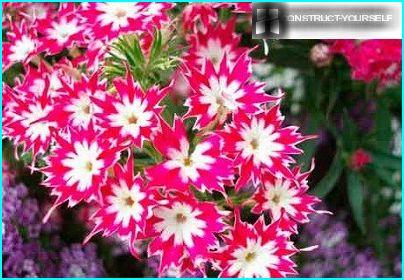
In addition to the annual Drummond Phlox of all the plants of this genus perennial
Phlox ground cover – flower bed decoration
It is a creeping plant, first blooming in the garden. Flowers they appear in mid-may. Very popular Phlox subulate. It is so named for the small oblong leaves shaped like an awl. The plant loves the sun. When planting it is important to choose not too waterlogged place to not rot the root system. When subulate Phlox fades, it should be cut by one-third. It stimulates growth and more abundant flowering the following year. In winter, subulate Phlox need to cover. Well suited for this dry foliage. Styloid Phlox are ideal for decorating the rocky hills.
Love gardeners use other varieties of groundcover Phlox – a lovely, forked, Douglas, Rovelli. They bloom in late may and are perfect for decoration of flower beds. Very interesting flowers Phlox Rovelli – purple-blue. Feature of pretty Phlox – undemanding to the soil. They can make retaining walls, foot of the stairs. The best time to plant groundcover Phlox – spring.

Styloid Phlox can be of any color of flowers – from white to various shades of purple
Ryhlodernistoe varieties – beautiful and unpretentious
They bloom after the ground cover. Ryhlodernistoe among the most popular varieties – splayed (canadian). Gardeners love it for the simplicity. Wild species flourishing blue flowers with a heady scent similar to violet. Under favorable weather conditions, the splayed Phlox is covered with flowers in late may and bloom for about a month. If the season is dry, the plant fades much faster. Color of flowers cultivated varieties varies from white to violet and purple. Planting Phlox splayed, you need to constantly monitor that it does not overgrown with weeds.
From ryhlodernistoe varieties is also very handsome solomonovy Phlox. It is widely used in landscaping because this species grows quickly and covers the ground like a splendid carpet. Flowers white, pink, blue flowers. Another nice for gardeners property is undemanding to light. Solomonovy Phlox thrives in shaded areas. It can be planted under trees. The plant tolerates damp.
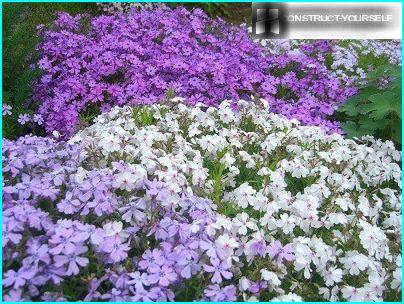
Flowers Solomonovo Phlox extremely beautiful. Especially interesting raspberry-pink color
Bush Phlox – for wet shaded areas
Bush varieties may be stunted (up to 1 m) and tall (over 1 m). From popular low-growing Phlox Carolina. Domestic gardeners prefer two varieties – «Bill Baker» and «Mrs. Lingard». First in appearance similar to Phlox canadian. Its color is petal pink. The second – highest among dwarf varieties (up to 110 cm). The petals are white. In Russia, these varieties are well acclimatized, because normally develop on acid soils.
From tall Bush varieties deserve special attention Phlox Arends. They bloom early and long delight the eye with fragrant flowers. They are planted thickly, as the plant stems are weak and can suffer from bad weather. Feature of the variety lies in the fact that after cutting they are able to blossom again. To do this, cut the shoots immediately after the first flowering.
For gardeners of interest are two kinds of spray Phlox spotted and paniculate. They are quite common. Spotted Phlox gets its name for the original color flowers. They are covered with purple streaks and spots. Variety can be planted in semidarkness. Phlox spotted often decorate the space around the reservoirs, the foot of the trees. The most popular varieties – «Rosalind», «Omega», «Alpha», «Delta», «White pyramid», «Natasha». The advantage of Phlox paniculata in comparison with spotty – stronger stems.
Learn more about the variety of Phlox you can see from the video:
«Fire flower» in landscape design
The Phlox look great in single crop and composition. Styloid Phlox looks luxurious on the Alpine coaster. They are planting flower beds and lawns frame to give a more mottled appearance. Paniculata Phlox – perfect decor for unsightly items. For example, they can disguise old curbs. In lush flowering bushes are invisible tanks with water or other unpresentable, but the plot items.
Composition Phlox is used to model the space of the garden. They are well suited for a division into zones. Landscaped terrace these plants are placed on the second tier. This solution makes it possible to achieve a beautiful view of the terrace, whatever plants are not located on adjacent tiers. A good option – the landing of a bright lawn. If instead of grass area to plant Phlox, it will remind elegant colorful carpet. Medium Phlox decorate the edges of garden paths.

The Phlox are well suited for the design of banks of water bodies on the site
Looking for «good neighbors in the garden»
The Phlox is beautiful in and of themselves, so they can be planted separately. But many gardeners consider these flowers the simple-minded and prefer to be grouped in with other types of plants. Perhaps this opinion is not quite fair, but «dilute» Phlox still would not hurt.
One of the most advantageous options – planting Phlox on the background of silvery conifers. Also a good idea to plant next to the Phlox low-growing daylilies, for example, irises. They will cover the bottom part higher «fiery colors», and the composition would look complete.
Some gardeners create compositions of Phlox and roses. The idea is controversial, because both look amazing by themselves and in combination both can lose. But if you choose the right color scheme, such an experiment can be very successful. Will look good with bright roses, rich colors against white or pink Phlox.
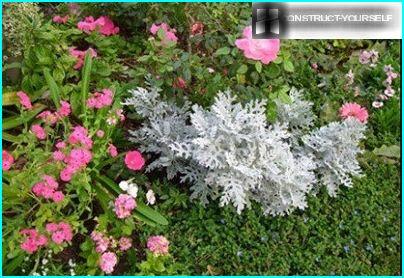
Version of the design: the combination of Phlox and roses with similar colors, «diluted» cineraria
How to combine colors in the garden design?
With a combination of different types of Phlox in one composition, you should remember the Golden rules of color harmony. Not worth it to plant flowers along with warm and cool colors. It is also desirable to combine two or more types of Phlox with the spotted and speckled petals. Composition of white Phlox on the background of dark colors often do not look very good because the dark background «eats» even a very beautiful white flowers. But dark against the white – version is quite acceptable. Aesthetically pleasing look of one color but different shades, planted consistently.
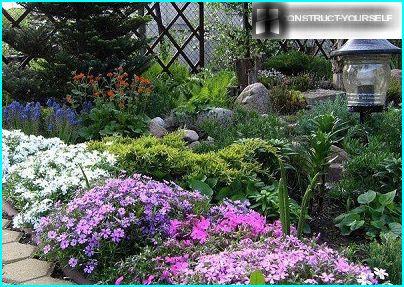
Multi-colored Phlox planted in groups along the border zone and decorate the space
Vegetative and seed propagation of Phlox
Like most garden plants, the phloxes are propagated by seeds, cuttings and division of plants. For division choose an adult Bush – from 3, better 4-5 years. If plans are to plant Phlox in the spring, the hive can be split into 15-20 parts, and in the fall better to be safe and to reduce the number of new plants to 4-7. This difference exists because in the spring phloxes succeed better and rooted.
Spring harvesting of cuttings
Grafted Phlox need from may until mid-summer. Then the percent survival of shrubs will be significantly higher. Harvest the cuttings from the entire stem of the plant. For this purpose it is cut into 2 nodes each. This is best done on a cloudy day. After harvesting, the cuttings are immediately planted in richly watered fertile soil to root.
The soil for planting cuttings is best to prepare yourself by mixing equal proportions of soil, sand and humus. Planted cuttings watered regularly. The ideal option is to cover them with tape. The root system begins to form about a month after planting plants.

For harvesting cuttings of the stalk, cut into several pieces, the tops are removed
Features autumn cuttings
If there is a need in the cuttings of Phlox «not in season», all manipulations should be conducted in a cool room with a constant temperature. For this purpose, suitable greenhouses and cellars. In autumn, the cuttings can not be directly planted in open ground, as they will not survive even the first signs of cooling. For planting choose a suitable container or pot in which the young plants take root and grow until spring. Planted on the site in may, when there is no risk of morning frost.
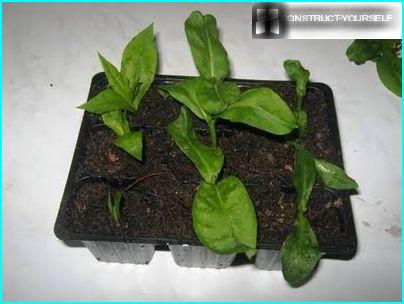
If the cuttings prepared in the autumn, they should be planted in a container
Reproduction flowers seeds
Growing Phlox from seed – a classic «gardening genre». Seed propagation of plants takes more time than vegetative, but it has the advantage of high adaptability. Phlox are grown from seeds, better adapted to the peculiarities of climate and soil. A significant disadvantage of this type of propagation – the possible loss of varietal characteristics. Plant seeds only makes sense if there are no other options or if the amount of planting material is more important than the preservation of the variety of features.
Seeds can be purchased or kick yourself. They are collected in time of wilting of the foliage. Then boxes already turn brown, but do not have time to crumble. Planting seeds can be directly on the site, and better indoors. The containers lay in a mixture of humus, sand and soil, planted seeds and covered with earth at 1-1,5 see In December, the containers are covered with snow, and in mid-March, transferred to the greenhouse. In the ground, the young plants are planted in late April. First – in greenhouse, after a month on the site.
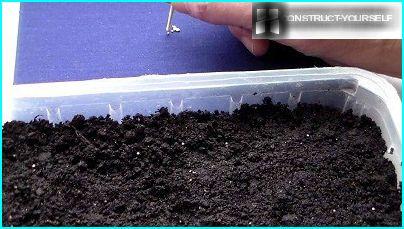
Planting seeds, you can put the container in the house on the windowsill
How to prepare the soil and plant the Phlox
Although plants tolerate polozhennye areas they are best planted in a well lit area so the blooms will be more plentiful and plants are better accustomed. Water should not stagnate. The suitable sandy soil, loamy soil with peat and humus. Very good humus from birch leaf litter and pine needles. You cannot make fresh manure.
Loosen soil, remove weeds, fertilize with compost, watered. The spring planting can be planted Phlox immediately after the defrosting of the soil. Then, the probability that they will bloom this season. Autumn planting to mid-October.
Plants are planted at a distance of 35-50 cm from each other. A closer location is necessary only if the planned landing in a Bush. Old plants in need of transplanting. If the flowers become smaller, it is time to think about renewal of the Phlox. It dug, separated and transplanted.
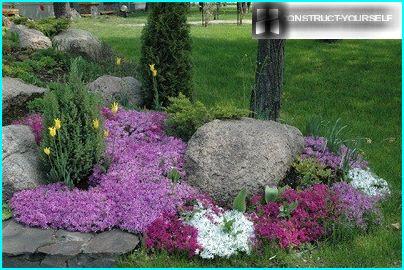
The first signs of aging plants may occur on a 3-5 year life, then it is time to divide and transplant
You need the colors for the normal development
Caring for Phlox is a little different from caring for other garden plants. They need to weed, loosen the soil, crop dried shoots. If the gardener wants to grow a low-growing Bush and volume, you can periodically do the nipping. It should be remembered that pinching delays the flowering period of the plant for about two weeks and then a month. It is best done in may. The later is manipulation, the longer the Bush is not blooming.
Phlox equally as poorly tolerate excessive soil moisture and drought. In the summer they have water. This can be done not only in the morning and evening, but during the day. The main thing is to pour water at the roots, and try not to splash on leaves. In hot dry periods Phlox can be watered twice a day. To lock moisture in the soil mulch humus or peat. Enough layer of 5 cm.
Mineral fertilizers applied to the soil every week since the end of June to the end of the summer. The concentration of additives changes: it gradually increased from 2 g per liter of water to 8 grams, and then also reduce. Phlox prefer fertilizers with nitrogen and phosphorus. In «diet» add nitrate (2 g per liter of water). After mid-August to fertilize a plant is not necessary. In winter, the Phlox is desirable to hide, especially if they are newly planted.
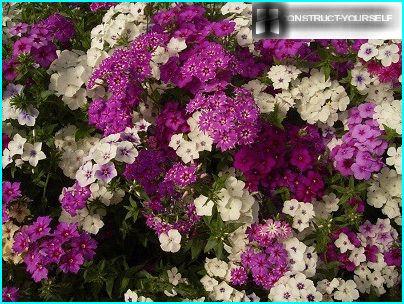
The plants bloom well, they need to be fed and that dive
Warning: danger: powdery mildew and leaf spot
Phlox often suffer from powdery mildew and gummy. Signs of diseases: dots and spots on the leaves, shrivelling them. Diseased leaves should be removed, and the Bordeaux plant to process liquid or analogues. You can spray for prevention. In this case, you should not wait for symptoms of the disease and the treatment need to be held in spring.
Plants can be attacked filamentous worms or nematodes. To avoid the misfortune, you should not plant Phlox in areas where there were wild strawberries. If the plant is already ill, the treatment method single – elimination together with a lump of earth and disinfecting lime soil.
For preventive and curative spraying can be recommended insecticides «Sumi-Alpha», «Karate», «Fury», «Kinmiks». Learn more about pest control explained in the video:






